 |
Home | Charity | Feedback |
Bhutan:
Bumthang,
Paro,
Phobjikha,
Punakha,
Thimphu
Paro, Bhutan: Gateway to sites galore by Prakash Bang, Editor in Chief 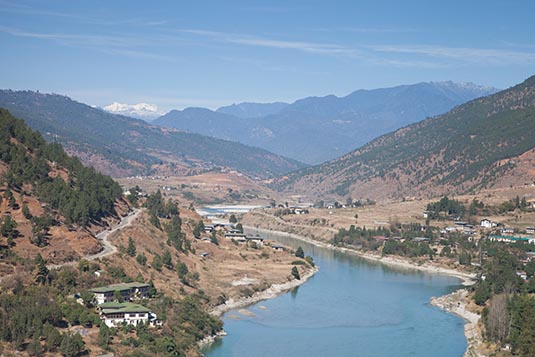 Paro is a historic town with many sacred sites and historical buildings scattered through the area. In addition, the Paro Valley is wide and verdant and is recognized as one of the most beautiful in Bhutan. 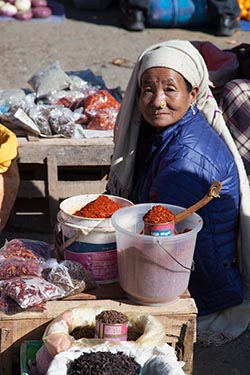 We commenced our drive from Phobjikha post breakfast. It would be a day of driving though the distance was just about 190 kms. Like I mentioned before, whilst traveling in Bhutan thereís no correlation between distance and driving timesÖ thanks to hilly and bumpy roads and of course the scheduled road blocks.
We commenced our drive from Phobjikha post breakfast. It would be a day of driving though the distance was just about 190 kms. Like I mentioned before, whilst traveling in Bhutan thereís no correlation between distance and driving timesÖ thanks to hilly and bumpy roads and of course the scheduled road blocks.
Thankfully, on this return journey, the sun was up and the skies were clear. Our brief stop at Dochula Pass was radically different than what we saw a few days ago. The location offered spectacular views of the eastern Himalayan range. By the time we reached our resort Zhiwa Ling, it was late in the evening. Zhiwa Ling is located along the Pa Chu river about 15 kms from Paro. Itís a sprawling property where one can easily spend a few days in its tranquil surroundings. Mr L B Gurung of Blue Sheep Tours was kind enough to invite us for dinner that evening. We raised the toast for the beautiful time that we had in this little country. It was time to say a big thank you to our guide and the driver. We deserved a good nightís sleep after the long travel that we had. 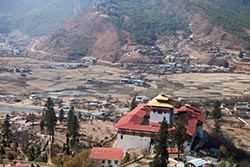 The next day was to explore Paro town and the vicinity namely the National Museum, local market, Drukgyel Dzong and the Tigerís Nest.
The next day was to explore Paro town and the vicinity namely the National Museum, local market, Drukgyel Dzong and the Tigerís Nest.
National Museum of Bhutan is a cultural museum in the town of Paro. It was established in 1968, in the renovated ancient Ta-dzong building, above Rinpung Dzong under the command of His Majesty, the King Jigme Dorji Wangchuck, the third hereditary Monarch of Bhutan. The necessary infrastructure was created to house some of the finest specimens of Bhutanese art, including masterpieces of bronze statues and paintings. Suitable galleries were constructed to house the extensive collections. Works of art are elegantly displayed on scientific lines. Today the National Museum has in its possession over 3,000 works of Bhutanese art, covering more than 1,500 years of Bhutan's cultural heritage. Its rich holdings of various creative traditions and disciplines, represent a remarkable blend of the past with the present. 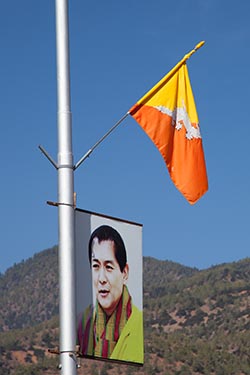 The action in Paro is limited to just one road Ė the main street. Shops are lined on both sides. While concrete is taking up the scene, there are a few facades that takes us back to the old world charm. We walked the street and also spent some time in the local vegetable market that was bustling with activities. From there we moved to the ruins of Drukgyel Dzong.
The action in Paro is limited to just one road Ė the main street. Shops are lined on both sides. While concrete is taking up the scene, there are a few facades that takes us back to the old world charm. We walked the street and also spent some time in the local vegetable market that was bustling with activities. From there we moved to the ruins of Drukgyel Dzong.
The ancient ruin of Drukgyel Dzong, considered as the most beautiful and famous archaeological sites in Bhutan, is situated on a ridge in the upper Paro valley. Since its construction in 1649, Drukgyel Dzong had been served as an important base for defense in the region until 1951 when it was destroyed by fire. Even after the destruction, the ruins of the Dzong continued to be protected as an important monument linking people of Bhutan with the great events that contributed in maintaining sovereignty of the country. Drukgyel Dzong is one of the Dzongs built by Zhabdrung Ngawang Namgyal, the linage holder of Drukpa-Kagyud Buddhist School and the unifier of Bhutan who came to Bhutan in 1616 escaping the conflict over recognition of the principal abbot of the Drukpa-Kagyud School in Ralung, Tibet. Zhabdrung Ngawang Namgyal and his successors constructed several fortresses called Dzong in the process of gaining control over different regions of the country, which were dominated by clergies and leaders of different Buddhist schools. These Dzongs were designed as fortress at the time of power struggles as well as a court of clergies and administrators after Zhabdrung Ngawang Namgyal established the unique dual government system headed by Je Kenpo (the Head of religious affairs) and Desi (the Head of temporal affairs). 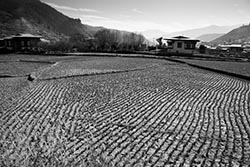 Unlike other Dzongs built by Zhabdrung Ngawang Namgyal and his successors, Drukgyel Dzong was served solely for defensive purpose without administrative and religious functions, especially against external threats from the border. The Dzong had housed the best armoury in the country at the time. As the name of the Dzong indicates (Druk is the local name for Bhutan, while Gyel means victory), it is said that it was built to commemorate Bhutanese victory over the combined forces of Tibetan and Mongolian army, which attempted several invasions to the country. Thus, the Dzong was built at the strategic site near the border with Tibet for strengthening defense against future invasions.
Unlike other Dzongs built by Zhabdrung Ngawang Namgyal and his successors, Drukgyel Dzong was served solely for defensive purpose without administrative and religious functions, especially against external threats from the border. The Dzong had housed the best armoury in the country at the time. As the name of the Dzong indicates (Druk is the local name for Bhutan, while Gyel means victory), it is said that it was built to commemorate Bhutanese victory over the combined forces of Tibetan and Mongolian army, which attempted several invasions to the country. Thus, the Dzong was built at the strategic site near the border with Tibet for strengthening defense against future invasions.
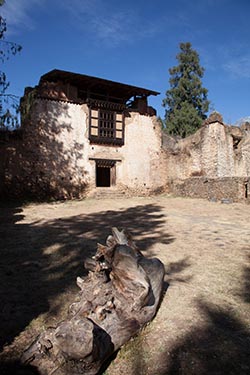 The existing ruins of the Dzong are comparatively well preserved. One can without much difficulty understand or distinguish features of the complex. Although most of timber components of the Dzong such as roof truss, door and window frames, and floors and ceilings are almost totally absent, major portion of stone and rammed earth wall structures are still standing. They provide for visitors in understanding ideas and practices for defense in the olden times.
The existing ruins of the Dzong are comparatively well preserved. One can without much difficulty understand or distinguish features of the complex. Although most of timber components of the Dzong such as roof truss, door and window frames, and floors and ceilings are almost totally absent, major portion of stone and rammed earth wall structures are still standing. They provide for visitors in understanding ideas and practices for defense in the olden times.
The Dzong consists of Utse, the central tower building, which housed a shrine of guardian deities, and Shabkhor, rectangular buildings surrounding the courtyards. It was built adapting to the geographical condition of the hill and formed a distinct design. The high and massive stone masonry walls of Shabkhor buildings stood on the steep slope of the hill entirely enclosing the inner space of the Dzong, making approach to Dzong possible only from the single entrance, which is heavily guarded by several ta-dzongs (watching forts) cylindrical in shape situated between the entrance and foot of the hill. Secret tunnels providing protected passages to fetch water from the river below the hill as well as to send troops during the time of war are said to have existed. Presently, cylindrical tower buildings called chu-dzong (water fort) can be seen connected with each other with paths enclosed by defensive walls. 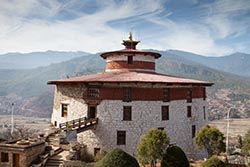 Paro Taktsang is the popular name of Taktsang Palphug Monastery (also known as Tiger's Nest). It's a prominent Himalayan Buddhist sacred site and temple complex, located in the cliffside of the upper Paro valley. A temple complex was first built in 1692, around the Taktsang Senge Samdup cave where Guru Padmasambhava is said to have meditated for three years, three months, three weeks, three days and three hours in the 8th century. Padmasambhava is credited with introducing Buddhism to Bhutan and is the tutelary deity of the country. Today, Paro Taktsang is the best known of the thirteen taktsang or "tiger lair" caves in which he meditated.
Paro Taktsang is the popular name of Taktsang Palphug Monastery (also known as Tiger's Nest). It's a prominent Himalayan Buddhist sacred site and temple complex, located in the cliffside of the upper Paro valley. A temple complex was first built in 1692, around the Taktsang Senge Samdup cave where Guru Padmasambhava is said to have meditated for three years, three months, three weeks, three days and three hours in the 8th century. Padmasambhava is credited with introducing Buddhism to Bhutan and is the tutelary deity of the country. Today, Paro Taktsang is the best known of the thirteen taktsang or "tiger lair" caves in which he meditated.
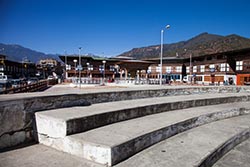 The monastery is located 10 kms. to the north of Paro and hangs on a precipitous cliff at 3,120 metres, about 900 metres above the Paro valley, on the right side of the Paro Chu. The rock slopes are very steep (almost vertical) and the monastery buildings are built into the rock face. Though it looks formidable, the monastery complex has access from several directions.
The monastery is located 10 kms. to the north of Paro and hangs on a precipitous cliff at 3,120 metres, about 900 metres above the Paro valley, on the right side of the Paro Chu. The rock slopes are very steep (almost vertical) and the monastery buildings are built into the rock face. Though it looks formidable, the monastery complex has access from several directions.
To reach the monastery one must be prepared to trek uphill for at least 3 hours. Itís not easy by any standards. And if it rains, the path becomes that much more slippery. Of course, one can hire a horse for the uphill journey. They need to foot it down as horses are not used to descend.  As much as I wished, I avoided the temptation to reach the top. Itís a shame that I missed a visit to Bhutanís icon. So be it. I walked up the path from where I could get a decent picture and that was it.
As much as I wished, I avoided the temptation to reach the top. Itís a shame that I missed a visit to Bhutanís icon. So be it. I walked up the path from where I could get a decent picture and that was it.
With that ended our Bhutan trip. The next morning we took a flight back to Pune via Delhi. Hereís a tip. When flying from Paro to Kathmandu to Delhi take a seat on the right hand side of the plane, behind the wings. You will witness, as I did, four of the world's top five peaks. Everest - 8848 metres - 1st in the world; Kanchenjunga - 8586 metres- 3rd in the world; Lhotse - 8546 metres - 4th in the world; Makalu - 8463 metres - 5th in the world. And not to forget Jomolhari - 7326 metres - 79th in the world. Happy viewing. Paro Image Gallery  Photo viewer Photo viewer
|
|
|
Home |
Charity |
Feedback
Privacy Policy | Terms of Usage © YoGoYo.com. All rights reserved. |























